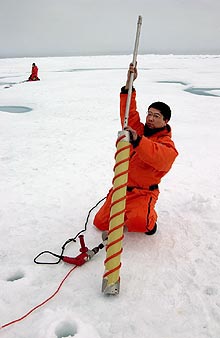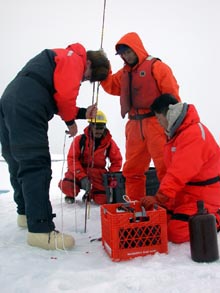
Qing Zhang, a member of the Chinese science team, removes a long cylindrical core of ice from the thick Arctic ice pack. (Photo by Emory Kristof, National Geographic Society.) Click image for larger view.

Terry Whitledge, Sang Lee, Bo Chen, and Joe Illasiak lower the primary productivity sampling equipment into the hole created by the removal of the ice core. (Photo by Rolf Gradinger, University of Alaska Fairbanks.) Click image for larger view.
Highlights of Nutrients and Pelagic Primary Productivity
August 14 - September 8, 2002
Dr. Terry Whitledge
University of Alaska, Fairbanks
While in the field, we can approximate the number of phytoplankton in the water by studying the amount of brownish-green-colored particles obtained on filters. Using this technique, we found a curiously high concentration of phytoplankton in the water only inches below the ice surface during the summertime in the Canada Basin. Meanwhile, the concentrations of phytoplankton decrease rapidly to low values just a few feet deeper. This decreasing trend continues down to almost 150 ft, where the waters have a different origin.
This observation of high concentrations of phytoplankton near the bottom of the ice may indicate that melting water from the ice may contain some important nutrients that stimulate phytoplankton growth. Another possibility is that the ice provides a solid cover to the water column that reduces wind disturbance of the upper layers of water. This possibility would reduce mixing and allow the plant cells to remain near the surface rather than being mixed downward.
The relatively large concentrations of phytoplankton near the bottom of the ice also indicate that this would be a good location for a grazing animal to find a juicy meal. It will be exciting when the final data is obtained in our laboratory and we can compare our results with other investigators who are studying animals in the ice and water column.
For more information regarding the Primary Productivity Ecological Group, see the September 1 Log.
Sign up for the Ocean Explorer E-mail Update List.


























